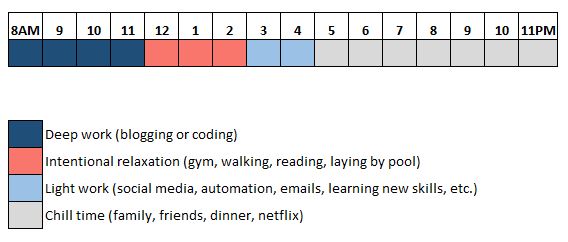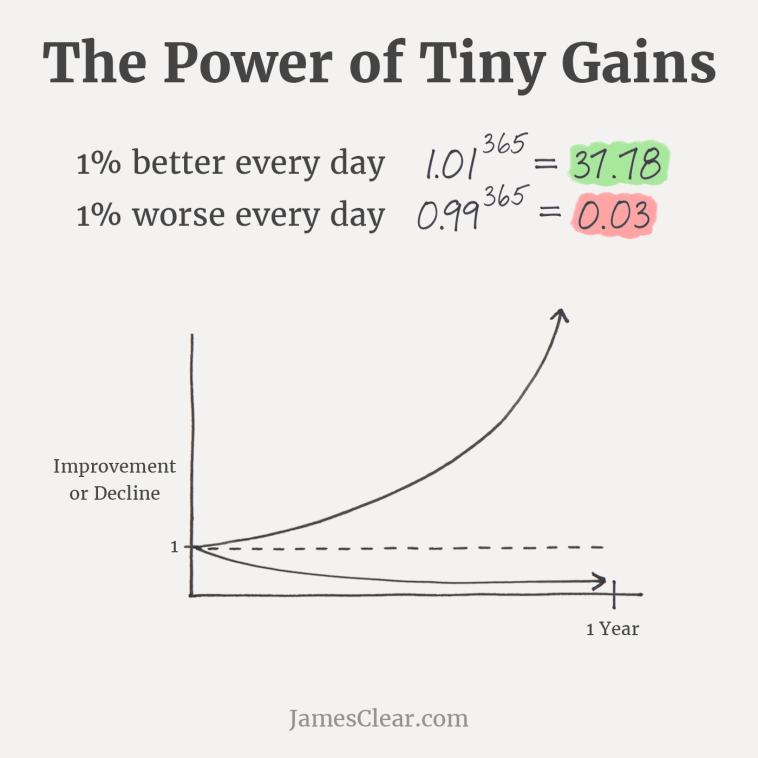
5 min read
Ever since I quit my day job as a data scientist a little over three months ago, I’ve had the luxury of waking up each morning and getting to decide exactly how I’d like to spend my day.
This complete freedom over my time is the one thing that I craved most during my time in Corporate America. I hated being told what to work on, what schedule to follow, where to work, and whom to work with. Despite the cushy income, I felt trapped.
Now that I have the freedom I craved, I can do whatever I want each day. However, one surprising realization I’ve had is that complete freedom can actually be paralyzing at times.
While I can spend my time doing productive things like working on projects I find meaningful, lifting weights, reading books, and meditating, it’s just as easy to spend my time binging on Netflix shows, watching pointless videos on YouTube, and eating snacks on the couch.
Freedom from a day job means I get to choose how I spend my time. And while complete freedom might sound like a dream come true, it can actually be paralyzing at times. To understand why, we can turn to Barry Schwartz who wrote an entire book on this topic titled The Paradox of Choice.
The Paradox of Choice: Why More Isn’t Better
One of the most famous experiments in consumer psychology is known as the “Jam Study.” In a study conducted at a high-end Bay-area supermarket, psychologists Sheena Lyengar and Mark Lepper found that consumers were 10 times more likely to purchase jam on a display when the number of jams available was reduced from 24 to 6.
This seemed like a paradox. Shouldn’t more choices lead to more sales since consumers are more likely to find something they like?
However, this phenomenon of more choices leading to fewer sales popped up in a variety of studies from financial services to speed dating to chocolate sales. At some point, this became known as “the paradox of choice.” It’s a paradox because it’s counter-intuitive that giving consumers fewer options actually causes more sales.
It turns out that the reason more choices cause fewer sales is because it creates a psychological burden for consumers. More choices means more time and effort required to make a decision and an increased likelihood that the consumer will make the wrong choice and regret it.
In The Paradox of Choice, Schwartz explains that if you have too many choices, this optionality can become debilitating rather than liberating:
“When people have no choice, life is almost unbearable. As the number of available choices increases, as it has in our consumer culture, the autonomy and liberation this variety brings are powerful and positive.
But as the number of choices keeps growing, negative aspects of having a multitude of options begin to appear. As the number of choices grows further, the negatives escalate until we become overloaded. At this point, choice no longer liberates, but debilitates. It might even be said to tyrannize.”
One way to wrap your head around this paradox is to visualize the scenario presented in the famous Jam Study. Imagine there are 24 jams lined up on a shelf:

There are probably some jams that you know you wouldn’t like (red), some you might like (yellow), and some you would definitely like (green):

Even if you’re able to narrow it down to 8 jams you would probably like, this means there’s only a 1 in 8 chance that you choose the best possible jam. After you make your purchase, there might be the lingering thought of “what if one of those seven other jams would have been better?”
So, it takes serious time and effort just to narrow down your choices. Then, even after you’ve made your choice, there’s the possibility that you made a sub-optimal decision.
Contrast this with the scenario of having only 6 jams to choose from:

Perhaps there are 2 you know you wouldn’t like (red), 2 you might like (yellow), and 2 you would definitely like (green):

Not only is it easier to make a decision in this scenario, but there’s also a higher probability that you pick the best possible jam.
Too Many Choices Causes a Failure to Act
Just as too many product choices can be paralyzing for consumers, too many choices for how to spend one’s time can also be paralyzing.
Given the gift of complete freedom over your time, you can choose to work on projects, travel to different places, spend time with family, spend time with friends, exercise, read, meditate, lay around all day or do any number of other things. You have an unlimited amount of choices.
Unfortunately, the easiest action to take when you have so many choices is no action at all.
Because of this, I’ve personally found that the best way to optimize my freedom is not to wake up each day and ask myself “What should I do today?” but rather to set up a daily routine that restricts the number of choices I have to make and also ensures that I spend my time doing things I deem to be important.
The Joy of Fewer Choices
“Learning to choose is hard. Learning to choose well is harder. And learning to choose well in a world of unlimited possibilities is harder still, perhaps too hard.” -Barry Schwartz, The Paradox of Choice
The things that bring me joy and meaning in life can be boiled down into three categories:
1. Good health
2. Good relationships
3. Good work
If I have a healthy body and mind, a strong social network, and the ability to do meaningful work, I have everything I need in life.
I’ve found that the best way to prioritize these three things is to set up a daily routine that naturally leads to me spending time on them. In a previous post, I shared the daily routine that works best for me:

This routine ensures that I spend plenty of time doing meaningful work, exercising, and being around family and friends. By following this routine, I don’t waste time deciding what to do or where to go each day. I largely follow the same routine day in and day out:
- Wake up, do my morning 15-minute meditation, then take a cold shower.
- Head to the local coffee shop to work on my sites for the next ~4 hours.
- Either go to the gym to lift weights or go for a walk.
- Come back to my apartment and do a couple hours of light work.
- Spend the evening with my girlfriend, friends, or family.
It also turns out that there are tons of research-backed mental health benefits of maintaining a daily routine including:
- Less anxiety
- Less stress
- Increased productivity
- Increased creativity
Along with these benefits, a proper daily routine is a necessary ingredient for becoming great. Whether you want to be great at writing, meditating, lifting weights, or anything else, you need to be able to show up each day consistently and put in quality work.
As Steph Smith once wrote, the way to be great is to be good repeatably. And the way to be good repeatably is to be consistent. And the way to be consistent is to create a daily routine that makes it easy to show up and work on your craft each day.
As James Clear shares, there is power in tiny gains. Getting 1 percent better every day counts for a lot in the long-run.

Financial Independence and Artificially Restricting Freedom
Many people crave financial independence because it gives them complete freedom over their time. However, complete freedom can feel abnormal if all you’ve ever known is a 9-5 lifestyle where much of your daily schedule is decided for you by an employer.
While F.I. is a wonderful thing to pursue, it’s important to keep in mind that the freedom that comes with it can be paralyzing if you don’t have some type of routine. That’s why, on the road to financial independence, it’s important to gain an understanding of the things that bring you joy so you know how to prioritize your time once you have the freedom you so badly crave.
When you set up a daily routine, you artificially restrict your freedom. However, because you are the one who determines this routine, this restriction actually liberates you from the obligation to decide day in and day out how to spend your time.
- The Ad Revenue Grid - August 6, 2021
- Attract Money by Creating Value for a Specific Audience - July 13, 2021
- The 5-Hour Workday - March 26, 2021
Full Disclosure: Nothing on this site should ever be considered to be advice, research or an invitation to buy or sell any securities, please see my Terms & Conditions page for a full disclaimer.

